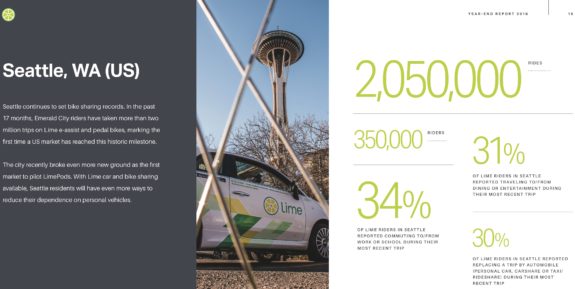
People in Seattle have taken more than 2,050,000 trips on Lime bikes since the company launched in summer 2017, according their annual report. That’s a pace of about 1.5 million trips per year for just one of the companies serving the city with shared bikes.
There are few precedents for an urban mobility service that has so quickly served so many trips. Transit services often take years or decades to plan and launch. So especially for a city that is facing a very near-term traffic crunch, a non-car service that can carry so many trips is a huge deal.
And we still have not seen the city’s bike share permit reach its true ambition. Motivate/Lyft is supposed to join Lime and JUMP/Uber, combining to reach as many as 20,000 bikes. And as other cities have shown, adding shared electric scooters to the mix could carry even more trips than the bikes. The city has so far been resistant to adding scooters. Ensuring and demonstrating that the devices will be safe on steep hills will be vital for companies trying to ease concerns at City Hall.
Meanwhile, Lime has expanded into car share with the launch of Lime Pods in Seattle. While this blog does not typically cheer on car services, I actually like car share. As someone who grew up in a car-depended suburb in Missouri, I know how scary it can be to make the leap and sell your car. When you’re used to having it, it’s hard to imagine life without it. Well, car share services can work like Nicotine gum. Knowing you have a car around if you really need it can make selling your car a bit easier.
Seriously, I cannot recommend selling your car highly enough. I have rarely ever felt such a sense of relief and personal freedom as I did watching the new owner drive that 1995 Nissan Maxima away. And you get a fat stack of cash.
The more people use car share, the less reason there is to build and reserve space for car parking.
ofo appears on the verge of collapse
Remember when ofo abruptly pulled out of the United States? Many wondered if their departure was related to Seattle’s big increase in permit fees, but others speculated that the sudden departure was a sign of trouble back in China where the bulk of their business is.
Well, the enormous bike share company appears to be on the verge of collapse as their user base rushes to get their deposits back. ofo is the biggest bike share company in the world, so their demise could be the most dramatic example of China’s bike share bubble bursting. It might seem like there are a lot of bike share bikes on the streets in Seattle, but the recent boom in bike share in China is on a massively larger scale. Seattle counts bikes by the thousand. ofo has launched millions of bikes. When I interviewed an ofo spokesperson back in early 2017, they said the company’s goal was to “unlock every corner of the world.”
Some day, I bet ofo will have a paragraph or two in a lot of economics text books.










Comments
9 responses to “People in Seattle have taken more than 2M Lime trips + ofo appears to be imploding”
Please, no electric scooters on Seattle’s hilly sidewalks & roadways.
I think scooters would work great in Seattle on flat trails, like the Burke-Gilman, but putting scooters on the steeper streets feels unwise. Downtown especially has a number of east/west streets that feature a combination of extreme grades and heavy traffic. It seems inevitable that people are going to try to ride down Columbia and see how fast they go. When they discover that scooter brakes don’t stop as well as bike brakes, and plow through a red light at the bottom of the hill, that’s an accident waiting to happen.
That said, I do think this is a problem that can be solved, in part, by the scooter technology, itself (although the scooter companies may not have implemented the way to do it yet). For example, the scooters could be programmed to enforce a speed limit with brakes, not just cutting off the motor, so, even going downhill, it would be impossible to ride it too fast.
Another feature that might get over a lot of the objections could be to have “walk zones”, where the speed limit is reduced to 3 mph (again, enforced with brakes, so, even on a downhill, you can’t exceed it). Basically, busy downtown sidewalks get designated as walk zones. Similar with streets on steep hills (to get people to walk the scooter down the sidewalk, instead). But flat’ish streets, bike lanes, trails, and wide sidewalks with relatively light foot traffic (e.g. Mercer), users would be allowed to get up to 15 mph. A display screen on the scooters would clear indicate to the user when you are in a “walk zone”.
So…
1. GPS isn’t good enough to reliably make the kinds of distinctions you’re talking about.
2. Even if GPS plus some other on-board processing gets you to good-enough/reliable-enough coordinates, developing and maintaining data on the locations of sidewalks and bike lanes at this level of granularity is not cheap. Such an effort would at least need to take into account construction activity. Maybe even emergency responses!
3. Even if we somehow knew exactly when a slow-down was necessary, we’re talking about the scooter making a unilateral decision to brake, without input from its rider. This braking can take place in one of three places:
– On the front wheel. The front wheel is where you have the most braking power. But a rider’s center of mass is high and quite far forward — there’s a really big risk of throwing the user over the handlebars if the user is not prepared to throw weight backwards!
– On the rear wheel. Here you have less braking power and a high risk of locking up the wheel (especially with solid tires that have been exposed to the elements for a while… probably not the most grippy).
– With a drag brake against the ground. There are a bunch of risks here: hitting a bump or simply braking too hard (especially if the rider isn’t planted exactly where expected) could cause the wheels to lose contact with the ground. At that point you’re probably losing control!
All these can be perilous on any two-wheeled vehicle, especially if the rider is leaning or turning. I’d never accept a bike deciding to brake for me, and a scooter has much worse center-of-mass issues! Ultimately what makes biking work is that we are in control. We control ourselves with subconscious, intuitive knowledge of our positioning and of our intentions. The machine can’t take over these functions — not just because the machine isn’t smart or fast enough, but because the human is bigger, stronger, and more massive than the machine! Because the human’s mass is higher and wider than the machine’s!
And if this is reversed? If the machine is massive and powerful and if its base outflanks the human’s mass, providing the necessary stability? Then the machine loses its a lot of its ability to fit smoothly, informally, unobtrusively into urban life.
What all this means is that we have to trust people to act responsibly in the public realm. That is socially true but it’s also enforced by physics. No human trust, no public realm.
Good point. Maybe gps-triggered automatic breaking simply creates more safety problems than it would solve.
As someone that owns a car I don’t use much… the new-style car-share services are useless for every trip I actually use my car for: trips where I’m traveling outside the city, or would need to keep the reservation going for a couple hours because it’s in a parking lot. Even if the service area was expanded and they worked out some kind of deal for parking lots, if I ended my reservation in some remote suburban parking lot and then someone else drove it off there’s a good chance I’d be a long way from the next available one… and then I’d have the wait and the expense of a cab ride back home. I’m not selling my car for that!
Meanwhile I already have a solution for trips within the city to locations where street parking prevails: my bike! And these new services are killing off the ZipCar model that could actually serve my needs! So in the end it’s… more cars for bikable trips and fewer cars for not-so-bikable trips.
Both ReachNow and Car2Go have intermediate pricing that is ballpark competitive with ZipCar. Example: zipcar estimates a 3-hour shopping trip will be $32. Say the 3-hour trip is 60 min driving and 120 min parking. That would be $27+12 for ReachNow ($0.45/min driving, $0.10 parking). Reachnow also has a flat-rate of $50 per 3 hours, so if you ended up driving more and parking less you wouldn’t be out a lot. Car2Go doesn’t give a break for parking but has preselected packages – 2h package for $29, 4h package for $55. Both have 1-day rates at $80. So a little more expensive than ZipCar but not 2x more.
Over the years, my usage of Zipcar has almost disappeared. Between Lyft, Uber, Car2Go, and ReachNow, not to mention all the bus/bike options, it just almost never makes sense to rent a Zipcar anymore.
Pretty much any destination within 20 miles, if you’re staying there for at least 2-3 hours, Lyft and Uber are likely going to be flat-out cheaper.
What I don’t like about the ofo meltdown is that one company’s bad bookkeeping is being framed by some as “proof” that bicycles aren’t practical as transportation so you should go out and buy a huge honkin’ macho-complex mega truck to go to three blocks to the store to get some milk.
When ofo first came into this continent I thought their business model was a bit sleazy and verging on scamming venture capital, blah blah blah… (I’m not even someone who’s familiar with how business works and even I could see problems with it.) but I was dazzled by the convenience as a consumer. I think dockless bike share in general is pretty handy. I had some good times visiting Seattle and didn’t have to bring a bike with me on Amtrak to do it. I liked that. (In earlier trips to Seattle I used Pronto which made some pretty basic mistakes that I just gave up on it after a couple days and used transit.)
For any city, the main thing is infrastructure. It will mean that companies like Limebike, ofo, Pronto, etc. can have clientele, it means that regular folks who find that it’s a big hassle to fire up the ol’ car to do a simple short trip, it means that people who because of low income and/or disability cannot have or get licensed for a car can have mobility, and just to make the experience of living in a city be nicer, cycling infrastructure (which can be used by scooter, skateboards, rollerblades, etc.) is a necessity.
For what its worth, I spend some time in China in October, and ofo, although ubiquitous, was regarded as having the worst bikes out of the dozen or so competing bike-share companies. They simply maintained their bikes the worst and didn’t innovate to keep up with the competitors.